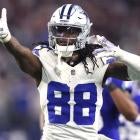
How much is too much to pay a quarterback? Plenty of experts around the NFL would argue there is no such number. If you want a franchise QB, you do whatever it takes to get him. This offseason only reinforced the notion, for better or worse, with the Browns trading six draft picks and investing a record $230 million to land Deshaun Watson, even with the ex-Texans star potentially on the verge of a suspension stemming from 22 lawsuits alleging sexual misconduct.
But what if, contrary to popular opinion, there is a threshold for QB spending? Bookies' Adam Thompson has documented the earnings of every Super Bowl-winning QB since the NFL instituted the salary cap in 1994, and the numbers suggest there is, in fact, an optimal range for paying the man under center.
In a perfect world, of course, you're always winning games on a QB's rookie deal, when more money can be spent to surround the signal-caller with talent. But Thompson found that 21 of the 28 (or 75 percent) of the cap-era title-winning QBs have been top-three earners on their respective championship teams. All but two were top-10 earners. And almost half of them (13, or 46.5%) owned the largest salary-cap hit on the roster.
In other words, a clear majority of the championship QBs the last three decades have been highly paid.
That doesn't mean it's impossible to win with less lucrative QBs. Over the last 10 seasons, in fact, half of the title winners have had cap hits in the bottom half of starting-QB earnings: Joe Flacco (Ravens, 2012); Russell Wilson (Seahawks, 2013); Tom Brady (Patriots, 2016); Carson Wentz (Eagles, 2017); and Patrick Mahomes (Chiefs, 2019). Wilson, Wentz and Mahomes were on their rookie deals at the time, though Wentz also got his ring despite missing the playoffs due to injury.
The vast majority of Super Bowl-winning starters since 1994, however, own cap hits that take up between 10.6% and 12.3% of their respective team's entire salary cap, per Thompson. (Market-leading QB salaries have only escalated over the years, but so too has the NFL's cap, save for the 2020 pandemic-affected season.) For reference, the last two Super Bowl champions were Matthew Stafford, who was responsible for 10.69% of the Rams' 2021 cap; and Tom Brady, who took up 12.25% of the Buccaneers' 2020 cap. Most of them, again, are one of, if not the, highest-paid player on the team.
Here's the catch: just making your QB rich isn't enough. The "optimal" window may peak at 12.3%, as Thompson notes, but some QBs count for more than that percentage. Consider the top QB cap hits of 2022:
- Ryan Tannehill (Titans): 18.3%
- Patrick Mahomes (Chiefs): 17.2%
- Kirk Cousins (Vikings): 15.%
- Jared Goff (Lions): 15%
- Aaron Rodgers (Packers): 13.7%
Just because they're above 12.3% doesn't mean they can't win it all, just as QBs with rookie-deal cap hits (e.g. Joe Burrow, Justin Herbert) can't be written off. But the fact they take up so much of their respective caps suggests the talent around them just might be a little unbalanced in comparison to other teams/QBs. Look ahead to 2023, and you might have an early forecast of teams that may be even more unbalanced (or at least on the verge of cap trouble) because of high QB cap hits:
- Deshaun Watson (Browns): 24.1%
- Dak Prescott (Cowboys): 21.5%
- Patrick Mahomes (Chiefs): 20.5%
- Josh Allen (Bills): 17.4%
- Ryan Tannehill (Titans): 16%
Only one QB since 1994 has won a Super Bowl with a cap hit percentage higher than 13, per Thompson, and that was 49ers legend Steve Young, whose deal predated the salary cap itself.
So what is the perfect formula? It's not avoiding highly paid QBs so much as avoiding an imbalanced distribution of resources. The scales will always tip more heavily in the QB's favor, as opposed to wide receivers or linemen or literally any other position. The key, history suggests, is tipping it just enough. And perhaps knowing when to pull the plug on a signal-caller, even if it means entering a season of uncertainty.
There's not an easy practical application here; as the market shifts, the accomplished starters (and especially ones fresh off title runs, a la Stafford) inevitably command bigger deals. And there are predictably many occasions where teams swallow hard financial pills to avoid losing a proven, if unspectacular, commodity at QB (see: the Vikings extending Cousins this year despite kicking off a new regime). The best bet -- easier said than done -- is organically drafting and developing a starter who can be buoyed by elite support at premium positions. And, perhaps more important, making the right call, at the right time, as to whether he warrants a second or third contract ... or whether starting over, even to the dismay of win-starved fans, is wiser.
As for what this means for 2022, specifically? Thompson's formula leaves just two starting QBs in the "optimal" range: Russell Wilson, now with the Broncos; and Lamar Jackson, who's entering a contract year with the Ravens. Lesser-earning QBs on potential playoff teams, with theoretical chances to capitalize on better-distributed resources, include Allen (Bills), Prescott (Cowboys), Burrow (Bengals), Herbert (Chargers), Derek Carr (Raiders), Matt Ryan (Colts), Kyler Murray (Cardinals) and Jalen Hurts (Eagles). Time will tell if they can buck the trend, or if, on the other end of the spectrum, a more expensive one will do the same.


















